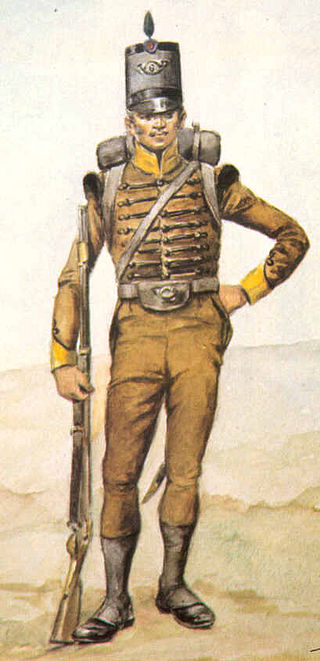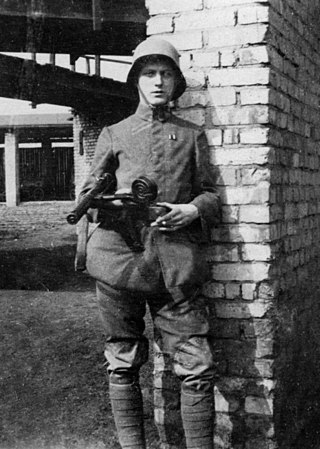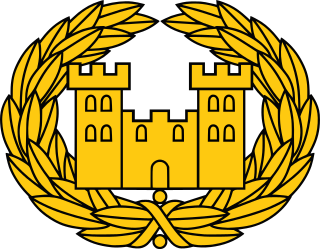
The Finnish Defence Forces (FDF) (Finnish: Puolustusvoimat, Swedish: Försvarsmakten) are the military of Finland. The Finnish Defence Forces consist of the Finnish Army, the Finnish Navy, and the Finnish Air Force. In wartime, the Finnish Border Guard becomes part of the Finnish Defence Forces.

Lauri Allan Törni, later known as Larry Alan Thorne, was a Finnish-born soldier who fought under three flags: as a Finnish Army officer in the Winter War and the Continuation War ultimately gaining a rank of captain; as a Waffen-SS captain of the Finnish Volunteer Battalion of the Waffen-SS when he fought the Red Army on the Eastern Front in World War II; and as a United States Army Major when he served in the U.S. Army Special Forces in the Vietnam War.

Jäger is a German military term referring to specific light infantry units.

A combat engineer is a type of soldier who performs military engineering tasks in support of land forces combat operations. Combat engineers perform a variety of military engineering, tunnel and mine warfare tasks, as well as construction and demolition duties in and out of combat zones.

The Finnish Army is the land forces branch of the Finnish Defence Forces. The Finnish Army is divided into six branches: the infantry, field artillery, anti-aircraft artillery, engineers, signals, and materiel troops. The commander of the Finnish Army since 1 January 2022 is Lieutenant General Pasi Välimäki.

The Utti Jaeger Regiment is the Finnish Army training and development centre for special forces and helicopter operations in charge of the Army Special Forces Unit and the Special Forces Qualification Course.

Detached Battalion 4 was a special forces unit of the Finnish Army during the Continuation War and Lapland War, serving from July 1943 to November 1944. The battalion was founded under the Intelligence Division of Defence Command from the already operational long-range reconnaissance patrol detachments created during the Interim Peace.

Light infantry refers to certain types of lightly equipped infantry throughout history. They have a more mobile or fluid function than other types of infantry, such as heavy infantry or line infantry. Historically, light infantry often fought as scouts, raiders, and skirmishers. These are loose formations that fight ahead of the main army to harass, delay, disrupt supply lines, engage the enemy's own skirmishing forces, and generally "soften up" an enemy before the main battle. Light infantrymen were also often responsible for screening the main body of a military formation.

A long-range reconnaissance patrol, or LRRP, is a small, well-armed reconnaissance team that patrols deep into enemy-held territory.

Jungle warfare or woodland warfare is warfare in forests, jungles, or similar environments. The term encompasses military operations affected by the terrain, climate, vegetation, and wildlife of densely-wooded areas, as well as the strategies and tactics used by military forces in these situations and environments.

Stormtroopers were specialist infantrymen of the Imperial German Army. In the last years of World War I, Stoßtruppen were trained to use infiltration tactics – part of the Germans' improved method of attack on enemy trenches. The German Empire entered the war certain that the conflict would be won in the course of great military campaigns, thus relegating results obtained during individual clashes to the background; consequently the best officers, concentrated in the German General Staff, placed their attention on maneuver warfare and the rational exploitation of railways, rather than concentrating on the conduct of battles. This attitude made a direct contribution to operational victories of Germany in Russia, Romania, Serbia and Italy, but it resulted in failure in the West. Thus the German officers on the Western Front found themselves in need of resolving the static situation caused by trench warfare on the battlefield.

The Reserve Officer School, located in Hamina, Finland, near the southeastern border, is responsible for the training of most Finnish reserve officers.
Shock troops or assault troops are special formations created to lead military attacks. They are often better trained and equipped than other military units and are expected to take heavier casualties even in successful operations.

Häme Regiment, was a unit of the Finnish Army located in Lahti. The regiment's main duty was to train conscripts and the personnel of the Finnish Defence Forces and the Finnish Frontier Guard.

Kainuu brigade is a Finnish Army unit situated in Kajaani. The brigade is one of the biggest army units, training approximately 4000 conscripts annually. The Kainuu Brigade is one of the three readiness brigades in the Finnish Army. The brigade trains troops for war-time Kainuu Jäger Brigade.
The military ranks of Finland are the military insignia used by the Finnish Defence Forces. The ranks incorporate features from the Swedish, German, and Russian armed forces. In addition, the system has some typically Finnish characteristics that are mostly due to the personnel structure of the Finnish Defence Forces. The ranks have official names in Finnish and Swedish languages and official English translations. The Swedish forms are used in all Swedish-language communications in Finland, e.g. in Swedish-speaking units of the Finnish Defence Force. The system of ranks in the Swedish Armed Forces is slightly different.

The Pori Brigade, based in Huovinrinne, Säkylä and Niinisalo, Kankaanpää is a Finnish Army unit directly under the command of Army headquarters. It comprises six battalion-level units and also trains soldiers for the Finnish Rapid Deployment Force.

Karelia Brigade is one of the three Finnish Army readiness brigades. It is currently based at Valkeala. With some three thousand soldiers it is the second largest brigade in Finland. It is the only Finnish brigade providing training in all Army branches and houses the Finnish Defence Forces Explosive Ordnance Disposal Centre of Excellence. As of 2023, its commander is brigadier general Jyri Raitasalo.
The Finnish Rapid Deployment Force (FRDF) is the spearhead international force of the Finnish Defence Forces (FDF). It can also be used for national defence.

The Battle of Ilomantsi was a part of the Svir–Petrozavodsk Offensive of the Continuation War (1941–1944). It was fought from 26 July to 13 August 1944, between Finland and the Soviet Union in an area roughly 40 kilometers wide and 30 kilometers deep, near the Finnish-Soviet border, close to the Finnish village of Ilomantsi, in North Karelia. The battle ended with a Finnish victory—the last major Soviet attack against Finland was stopped here.
















